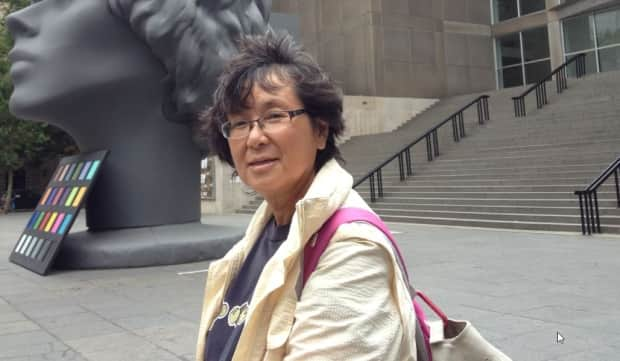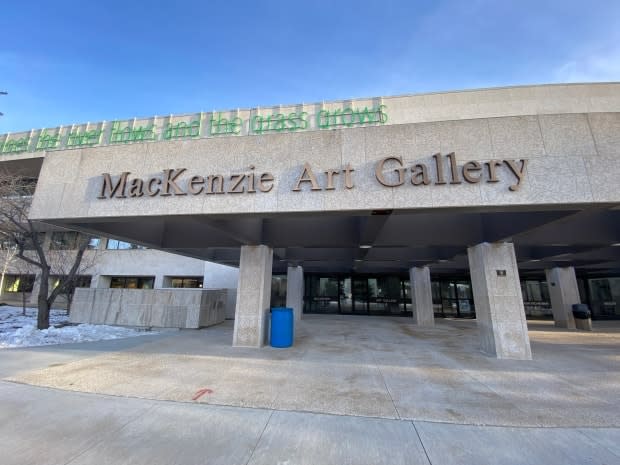Sask. art gallery reviewing 2,000 pieces following return of stolen Indian statue

A Saskatchewan art gallery is investigating 2,000 pieces in its collection following the return of a stolen statue to India.
CBC News was recently granted access to the basement vault of Regina's MacKenzie Art Gallery, where namesake Norman MacKenzie's journals and records are stored. They detail MacKenzie's theft of the Indian statue, but also raise questions about other pieces he acquired from China, Syria and elsewhere.
Galleries and museums across North America and Europe are facing demands to return pieces looted from other countries. Some say it's also time to debate whether names like MacKenzie should remain on those buildings.
"Institutions — whether they're local, provincial, national — all created a colonial narrative. The narrative was one of defeat. It's a colonial story," said Gerald McMaster, a Canada research chair at the Ontario College of Art and Design (OCAD) and director at the Wapatah Centre for Indigenous Visual Knowledge.
"I think the reckoning is coming."

The MacKenzie gallery's CEO John Hampton recently escorted CBC News to a basement door marked "Vault," keying in a series of security codes before entering. After donning blue latex gloves, Hampton opened a drawer containing MacKenzie's original dictated ledgers from his 1913 world trips.
MacKenzie had moved to Regina from Ontario years earlier and established a thriving law practice. His growing art collection was almost totally destroyed during the 1912 Regina Cyclone, the deadliest tornado in Canadian history, which killed 28 people.
MacKenzie and his wife then embarked on the first of two world tours to replace and enhance his decimated collection.
The story of the statue
Hampton opened the large, black leather-bound book and flipped through page after page of photos and descriptions of each piece. It included the story of the Indian statue.
MacKenzie had apparently dictated the story at some point after returning: He and his guide were rowing down the Ganges River in the holy city of Varanasi, then called Benares, when they came upon a Hindu temple.
He saw three stone statues at the edge of a pool filled with red liquid. MacKenzie assumed it was sacrificial blood, but gallery officials say it was most likely coloured with "sindoor," a red powder used in ceremonies.

MacKenzie talked to a man there who agreed to steal one of the statues. Later that night, the man brought all three to MacKenzie's hotel room.
MacKenzie said he'd only buy one, because he knew it was "a most serious offence" and he could have "gotten into trouble" with the British colonial government if he tried to smuggle out all three. MacKenzie told the man to return to the scene and put back the other two statues.
But he took the third statue — depicting goddess Annapurna — back home to Saskatchewan, where it remained for the past 108 years.
In the ledger entry, as with others, MacKenzie appears proud to have spirited out the rare religious artifact.
"This is the idol that I saw the people worshipping … and is a good sample of the type of idol which is used by the poorer classes," MacKenzie said.
Two years ago, visiting Winnipeg artist Divya Mehra raised questions about the statue, initially because it was mislabeled. Gallery officials investigated, concluded it belonged to the people of Varanasi and voluntarily returned it.
Upon its return last month, the Annapurna statue was draped in colourful robes and flowers and taken on a multi-city tour. Hindu faithful lined the streets to catch a glimpse of the procession to Varanasi.
Indian Prime Minister Narendra Modi, who represents Varanasi in parliament, lauded its return. He also thanked gallery officials and the University of Regina, which was bequeathed MacKenzie's collection after his death in 1936.
'Mixed emotions'
It was important for Annapurna to return home, said Hampton.
"There's definitely mixed emotions that we're all feeling here now; proud that we could take these steps, but also regret and shame, thinking that for over 100 years, she's been gone from that territory and stewarded at the MacKenzie for so long without the same sense of care that she receives in that home community," Hampton said.

There are now questions over other works in the MacKenzie collection.
MacKenzie's tours took him across Asia; he amassed a particularly large collection from China. At the time, many desperate, starving Chinese people were selling anything they had to survive.
According to MacKenzie's own notes — which are also chronicled in a 2010 journal article by University of Regina professor emeritus Gail Chin — he talked to a Japanese diplomat about his desire to possess a "valuable Chinese idol."
The man directed MacKenzie to two temples in the city of Soochow, now called Suzhou, where MacKenzie would find a monk "so hungry that he would trade food for an icon."
That's exactly what MacKenzie did. He placed the icon in his hand luggage and brought it back to Canada. That bronze, seated Buddha is still sitting in the MacKenzie Art Gallery's basement.
Chin has researched MacKenzie's Chinese collection, including the Buddha statue. In the 2010 article, she said MacKenzie's goal of bringing the world's art to the Canadian Prairies was noble on one level. But looking closer, she wrote, MacKenzie "wished for others to stand in awe of his taste, wealth and social position."
In an interview with CBC News this week, Chin was asked how she feels about Norman MacKenzie today. She paused for several seconds before answering.
"Well, I suspect that Norman MacKenzie would probably ask me to shine his shoes," said Chin, a third-generation Chinese Canadian.
"That was the social order back then, and I accept that. Society has changed, evolved. At least I hope so. Because along with Indigenous people, we all hope and pray for reconciliation."

There are also questions about MacKenzie's acquisitions of sacred religious items from other countries.
In 1930, MacKenzie bought a sculpture used in a funeral service in the Syrian region of Palmyra from controversial dealer Edgar Banks.
According to the journal Syria Archeology, Art and History, Banks looted dozens of sites across the Middle East and had been fired by the University of Chicago and other institutions for his unscrupulous practices in the years before that sale to MacKenzie.
Reconciliation as a central goal
The MacKenzie collection also contains scores of North American Indigenous art. Much of that was purchased directly from First Nations artists, but it will all be part of the 2,000-piece review now underway, Hampton said, who grew up in Regina and is a citizen of the Chickasaw Nation in the southern U.S.
Gallery officials said there will be a particular focus on MacKenzie's 400 antiquities.
Not all First Nations or international art was stolen or obtained unethically, said McMaster, a citizen of the Siksika Nation in Alberta, who grew up on the Red Pheasant Cree Nation near North Battleford, Sask.
But much of it was, he said, and the truth must come out.
The "colonial mentality" that allowed MacKenzie to steal art is the same mentality that allowed powerful white men to create the residential school system, McMaster said.

McMaster said three things need to happen at the MacKenzie and other galleries after the truth is exposed.
First, the talents and rights of these artists and cultures must be acknowledged.
Second, items must be returned to their rightful owners and communities, wherever possible.
Third, it's time to debate whether to keep names like MacKenzie on galleries and museums.
Floyd Favel, the curator of the Chief Poundmaker Museum, a new gallery and museum on the Poundmaker Cree Nation near North Battleford, Sask., agreed. His main goal is to repatriate any items stolen from his First Nation.
"One of the root causes of major institutions being in possession of stolen art or artifacts is due to racism; those institutions feeling that those people or that artist or that group is not worthy of that very beautiful work of art, whereas we are, because we're colonialists and we have a big museum," said Favel.
WATCH | Return of stolen Indian statue prompts review by Sask. gallery:
It's unclear how long the MacKenzie investigation will take. The gallery hopes to hire someone dedicated to that work and is searching for funding sources, Hampton said.
While some of MacKenzie's actions were deplorable, Hampton said, any discussion should balance these "very glaring blind spots" with the positive aspects. For example, MacKenzie was a firm believer that art should be seen by all, even hosting exhibitions for the general public in his own home.
As for the gallery itself — which opened two decades after MacKenzie's death — it was the first in Canada to host a show by Indigenous artists. Many of its curators and senior staff in recent years are Indigenous and from other diverse backgrounds. And reconciliation through art is now one of the gallery's central goals, said Hampton.
"I think that there's still a lot to admire about Norman MacKenzie and how he went about building his collection and thinking about the community here," Hampton said. "There's a lot to be celebrated, and then there's these elements that he needs to be held accountable."

 Yahoo Movies
Yahoo Movies 
